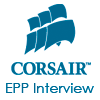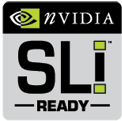- Qualcomm Launches Snapdragon 4 Gen 2 Mobile Platform
- AMD Launches Ryzen PRO 7000 Series Mobile & Desktop Platform
- Intel Launches Sleek Single-Slot Arc Pro A60 Workstation Graphics Card
- NVIDIA Announces Latest Ada Lovelace Additions: GeForce RTX 4060 Ti & RTX 4060
- Maxon Redshift With AMD Radeon GPU Rendering Support Now Available
Corsair EPP Technology Interview

NVIDIA unveiled a new technology designed for overclockers called EPP, or Enhanced Performance Profiles. NVIDIA chose Corsair to be their joint partner during production and in launch, so we sat down with John Beekley to ask some burning questions about the technology.
Page 2 – Continued Interview, Conclusion
TG: How long do you believe it will take EPP to become a stature in the memory world? Do you believe it will take very long for other memory manufacturers to pick up on the technology, and do you know if some already have?
JB: I believe we will see lots of EPP-enabled modules from many suppliers over the next few months, though I haven’t seen any yet. And all new XMS DDR2 modules from Corsair will be EPP-enabled. I am also aware of some very cool motherboards on the way that will take full advantage of EPP. I think the market will embrace this very quickly.
TG: From a technical standpoint, EPP uses bytes on the SPD that are unused. Does EPP fill up this extra space to the brim, or does it leave any room left for future use? In addition, is it technically feasible to increase the total byte size of the SPD to allow more information to be added in the future?
JB: EPP fills up this unused space pretty well. It is technically feasible to increase the size if necessary, but there are lots of ramifications, as vendors often use this area for other information. Corsair, for instance, uses bytes 128-255 to store parametric data for our XPERT modules. So, I would say that increasing EPP size is technically feasible, perhaps a bit problematic, but not impossible to implement, should a real need arise.
TG: Just the other day, you announced “SLi-ready memory”. Does this relate to the EPP, or is this a technology aside from it? Also, what do current memory modules lack that’s holding back some of our SLi performance?
 |
JB: SLI-Ready Memory is basically Nvidia’s term for EPP-enabled memory that they have qualified for performance and stability in their labs. Current modules aren’t holding back current SLI performance, but using SLI-Ready memory along with the Nvidia nFORCE 590 basically gives you a system designed for overclocking, with performance and stability that has been rigorously evaluated.
TG: In conclusion, what are your opinions on EPP thus far, and what do you hope to see it accomplish?
JB: Well, since I was very involved in the development of EPP, of course I think it is a fine idea, best thing since sliced pizza ;-)
But, taking a step back, here is what I think in a nutshell. I think EPP provides a huge benefit by incorporating specs like voltage and command rate that do not exist in the JEDEC SPD. This allows us memory guys to put a JEDEC compliant SPD on a module to ensure compatibility with all systems, but gives us a place to put the aggressive specs that the part is tested to.
For the novice overclocker, the existence of a high-confidence performance profile gives them a high likelihood of success in their early overclocking endeavors, presumably encouraging them to go further. For the experienced overclocker, it gives added visibility about how the manufacture recommends configuring the module (and, at least in Corsair’s case, tests it in the factory). I would not characterize it as a revolutionary advance, but rather as an evolutionary improvement that I wish someone had thought of long ago!
Thanks, Rob, for the chance to discuss EPP with your readers. These are all very good questions, and I hope my answers are thorough enough! This is an exciting time to be an enthusiast, with all the new platforms hitting the market. Happy overclocking!
EPP is not going to be a small project that people are just going to forget about. It appears that it is here to stay, and memory companies and motherboard manufacturers alike seem to be supporting it. All of Corsairs future DDR2 modules will incorporate EPP.
According to current spec sheets, each EPP enabled modules can be equipped with two full blown profiles, and four abbreviated ones. This will effectively take up 42 bytes in an SPD.
In my opinion, EPP sounds gimmicky at first glance, but it may have some real uses. It may prove beneficial for those enthusiasts that want to get into the wonderful world of overclocking, but allow them to take baby steps rather than diving in head first. There’s no doubt though, that to get the ‘maximum’ performance out of your PC, you are going to want to tweak everything by hand, but this may prove to be a great entry level way of doing things.
There’s still a burning question on my mind, but it won’t be answered until we can get our hands on some nF5 motherboards. As John mentioned in the interview, the EPP’s can set a ‘base’ for an overclock, and allow enthusiast overclocker’s to learn from that base and tweak accordingly. As far as I can tell, you are not currently able to set an EPP, and then immediately disable it and continue tweaking from the settings it laid. Rather, the BIOS will clear the options after unsetting a profile. This will be BIOS independent though, and there’s nothing holding back motherboard makers from incorporating this feature into their BIOS.
Considering EPP has not been released yet, it’s hard to tell at this point just how much of an affect it will have on our overclocking. One thing is for sure though, it’s an interesting concept. If it lives up to it’s promises, it may prove to be a feature that we will -want- in all of our motherboards. I wouldn’t be surprised to see ATi jumping onto a similar bandwagon, but I am willing to bet that Crossfire boards will not be able to utilize EPP’s in their current configuration.
We will report more on EPP as we get our hands on a compatible board and modules. Thanks again to John Beekley for taking the time to answer our questions.
Having something to say? Discuss this article in our related thread. You do not need to register in order to reply to any of our content threads.
|
|
Support our efforts! With ad revenue at an all-time low for written websites, we're relying more than ever on reader support to help us continue putting so much effort into this type of content. You can support us by becoming a Patron, or by using our Amazon shopping affiliate links listed through our articles. Thanks for your support!





